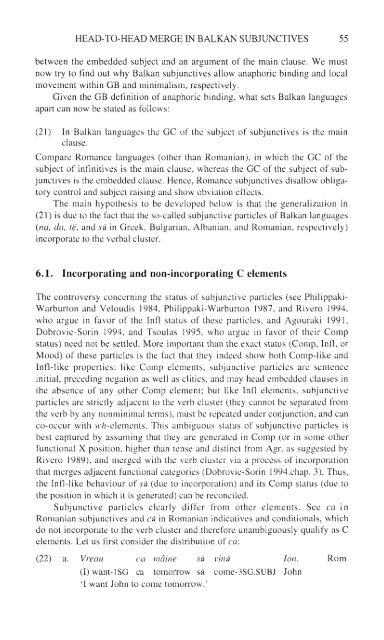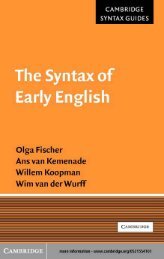Comparative Syntax of the Balkan Languages (Oxford ... - Cryptm.org
Comparative Syntax of the Balkan Languages (Oxford ... - Cryptm.org
Comparative Syntax of the Balkan Languages (Oxford ... - Cryptm.org
- No tags were found...
You also want an ePaper? Increase the reach of your titles
YUMPU automatically turns print PDFs into web optimized ePapers that Google loves.
HEAD-TO-HEAD MERGE IN BALKAN SUBJUNCTIVES 55between <strong>the</strong> embedded subject and an argument <strong>of</strong> <strong>the</strong> main clause. We mustnow try to find out why <strong>Balkan</strong> subjunctives allow anaphoric binding and localmovement within GB and minimalism, respectively.Given <strong>the</strong> GB definition <strong>of</strong> anaphoric binding, what sets <strong>Balkan</strong> languagesapart can now be stated as follows:(21) In <strong>Balkan</strong> languages <strong>the</strong> GC <strong>of</strong> <strong>the</strong> subject <strong>of</strong> subjunctives is <strong>the</strong> mainclause.Compare Romance languages (o<strong>the</strong>r than Romanian), in which <strong>the</strong> GC <strong>of</strong> <strong>the</strong>subject <strong>of</strong> infinitives is <strong>the</strong> main clause, whereas <strong>the</strong> GC <strong>of</strong> <strong>the</strong> subject <strong>of</strong> subjunctivesis <strong>the</strong> embedded clause. Hence, Romance subjunctives disallow obligatorycontrol and subject raising and show obvialion effects.The main hypo<strong>the</strong>sis to be developed below is that <strong>the</strong> generalization in(21) is due to <strong>the</strong> fact that <strong>the</strong> so-called subjunctive particles <strong>of</strong> <strong>Balkan</strong> languages(na, da, te, and sa in Greek, Bulgarian, Albanian, and Romanian, respectively)incorporate to <strong>the</strong> verbal cluster.6.1. Incorporating and non-incorporating C elementsThe controversy concerning <strong>the</strong> status <strong>of</strong> subjunctive particles (see Philippaki-Warburton and Veloudis 1984, Philippaki-Warburton 1987, and Rivero 1994,who argue in favor <strong>of</strong> <strong>the</strong> Infl status <strong>of</strong> <strong>the</strong>se particles, and Agouraki 1991,Dobrovie-Sorin 1994, and Tsoulas 1995, who argue in favor <strong>of</strong> <strong>the</strong>ir Compstatus) need not be settled. More important than <strong>the</strong> exact status (Comp, Infl, orMood) <strong>of</strong> <strong>the</strong>se particles is <strong>the</strong> fact that <strong>the</strong>y indeed show both Comp-like andInfl-like properties: like Comp elements, subjunctive particles are sentenceinitial, preceding negation as well as clitics, and may head embedded clauses in<strong>the</strong> absence <strong>of</strong> any o<strong>the</strong>r Comp element; but like Infl elements, subjunctiveparticles are strictly adjacent to <strong>the</strong> verb cluster (<strong>the</strong>y cannot be separated from<strong>the</strong> verb by any nonminimal terms), must be repeated under conjunction, and canco-occur with wh-elements. This ambiguous status <strong>of</strong> subjunctive particles isbest captured by assuming that <strong>the</strong>y are generated in Comp (or in some o<strong>the</strong>rfunctional X position, higher than tense and distinct from Agr, as suggested byRivero 1989), and merged with <strong>the</strong> verb cluster via a process <strong>of</strong> incorporationthat merges adjacent functional categories (Dobrovie-Sorin 1994.chap. 3). Thus,<strong>the</strong> Infl-like behaviour <strong>of</strong> sa (due to incorporation) and its Comp status (due to<strong>the</strong> position in which it is generated) can be reconciled.Subjunctive particles clearly differ from o<strong>the</strong>r elements. See ca inRomanian subjunctives and ca in Romanian indicatives and conditionals, whichdo not incorporate to <strong>the</strong> verb cluster and <strong>the</strong>refore unambiguously qualify as Celements. Let us first consider <strong>the</strong> distribution <strong>of</strong> ca:(22) a. Vreau ca incline sa vina Ion. Rom(I) want-1SG ca tomorrow sa corne-3SG.SUBJ John'I want John to come tomorrow.'
















